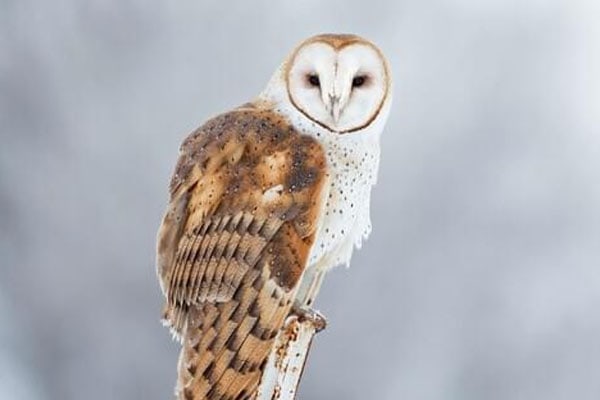Did you know that Arkansas is home to a diverse population of owls, with at least 7 different species inhabiting its forests and woodlands? These magnificent creatures captivate us with their majestic presence and mysterious behaviors, making every encounter with them a truly unforgettable experience. Join me as we delve into the enchanting world of owls in Arkansas, where nature’s magic unfolds.
Main points to note:
- Arkansas is a haven for owl species, with at least 7 different types found in the state.
- Exploring the habitats and behaviors of owls can provide unique wildlife encounters.
- Each owl species in Arkansas has its own distinct characteristics and habits.
- Forests, woodlands, and open fields are ideal places to search for owls in Arkansas.
- Listening for their distinct calls can help in locating these captivating creatures.
Eastern Screech-Owl
The Eastern Screech-Owl is a small owl species commonly found in Arkansas. With its compact size and captivating appearance, this owl is a favorite among bird enthusiasts and nature lovers. Owls in Arkansas are known for their diverse habitats, and the Eastern Screech-Owl can be spotted in various forested areas and woodlands.
Distinctive Call and Behavior
One of the most remarkable characteristics of the Eastern Screech-Owl is its distinctive call.Eastern screech-owls produce a series of musical trills and whinnies, creating a hauntingly beautiful chorus that echoes through the night. These vocalizations serve as a territorial display and communication between mating pairs.

During the daytime, the Eastern Screech-Owl often finds refuge in tree cavities or dense foliage, camouflaging itself perfectly with its surroundings. Its unique plumage, which can be gray or red, provides excellent camouflage against the bark of trees or the leafy canopies. This owl species is highly adaptable and can be found in both rural and suburban areas in Arkansas.
Spotting the Eastern Screech-Owl in Arkansas
If you want to catch a glimpse of the Eastern Screech-Owl in Arkansas, there are a few essential tips to keep in mind. First and foremost, owls are most active during the twilight hours of dawn and dusk, so plan your birdwatching expeditions accordingly. Secondly, listen for their distinctive calls,owls in Arkansas, including the Eastern Screech-Owl, are known for their vocalizations, which can guide you in the right direction.
When scanning the trees for the Eastern Screech-Owl, pay attention to tree cavities or hollows, as they often use these as daytime roosting spots. Binoculars can be a valuable tool to spot owls, especially in densely wooded areas where they may be difficult to see with the naked eye.
Fascinating Adaptations
The Eastern Screech-Owl possesses remarkable adaptations that enable it to thrive in its natural habitat. Its keen hearing, for example, allows it to locate prey in total darkness. Large, forward-facing eyes provide exceptional depth perception and precise targeting of prey during nocturnal hunts.
Furthermore, the feathers of the Eastern Screech-Owl have specialized edges that reduce noise, allowing for silent flight. This stealthy hunting technique helps them surprise their prey, which includes small mammals, birds, and insects.
Protecting the Eastern Screech-Owl
As with all wildlife, it is crucial to respect and protect the Eastern Screech-Owl and its habitat.Owls in Arkansas rely on healthy ecosystems to thrive, so it is vital to preserve their natural environments. Avoid disturbing tree cavities or nesting sites and refrain from playing owl calls to attract them. Instead, observe them from a respectful distance, use binoculars, and enjoy their beauty in a non-intrusive manner.
The Eastern Screech-Owl is just one of the many fascinating owl species that call Arkansas home. In the next section, we will delve into the world of the Great Horned Owl, another magnificent owl species found in the state.
Great Horned Owl
The Great Horned Owl is an impressive and majestic species that can be found throughout the beautiful state of Arkansas. As one of the largest owls in Arkansas, it commands attention with its size and striking appearance.

This powerful hunter is known for its distinctive “hoo-hoo-hoo” call, which can be heard echoing through the forests and woodlands of Arkansas. This haunting call serves as both a territorial announcement and a method of attracting a mate.
The Great Horned Owl is highly adaptable and can be found in various habitats across the state. It is equally at home in open fields, dense forests, and even urban areas. This adaptable nature contributes to its success as a predator and ensures its survival in the ever-changing landscape of Arkansas.
Behavior and Adaptations
The Great Horned Owl possesses several impressive adaptations that make it a formidable predator. Its large eyes are perfectly suited for low-light conditions, allowing it to spot its prey even in the darkest of nights. Additionally, its sharp, curved talons and powerful beak enable it to capture and kill a wide range of prey, including small mammals, birds, and reptiles.
This species is known for its exceptional hunting skills and has been observed taking down prey much larger than itself, such as raccoons and skunks.
Great Horned Owls are primarily nocturnal, meaning they are most active during the night. However, they can also be seen hunting during the day, especially during the breeding season when they are caring for their young.
When it comes to nesting, the Great Horned Owl is known for its adaptability. Instead of building their own nests, they often repurpose nests built by other birds or use natural cavities in trees. This flexibility allows them to establish breeding territories in a wide range of habitats, from dense forests to suburban areas.
Where to Spot Great Horned Owls in Arkansas
If you’re hoping to catch a glimpse of the magnificent Great Horned Owl in Arkansas, it’s important to look in the right places. This species can be found throughout the state, but they tend to prefer areas with a mix of open spaces and trees, such as forested edges, farmlands, and parks.
Keep your eyes and ears open during the evening and early morning hours when these owls are most active. Look for signs of their presence, such as their iconic call or the remains of their prey, which they often leave behind near their nesting sites.
To increase your chances of spotting a Great Horned Owl, consider joining local bird watching groups or participating in guided nature walks led by experienced birders. These experts can provide valuable insights and help you navigate the best locations to observe these incredible creatures in their natural habitat.
| Physical Characteristics | Behavior | Habitat |
|---|---|---|
| The Great Horned Owl has a wingspan of approximately 3.3 to 4.8 feet and can weigh between 2.5 to 5.5 pounds. It has large yellow eyes, prominent ear tufts, and a mix of dark and light brown feathers that provide excellent camouflage. | They are solitary birds and often establish territories that they fiercely defend. Males and females have distinct roles in raising their young, with the female incubating the eggs and the male providing food for the family. | They can be found in a variety of habitats, including forests, woodlands, swamps, deserts, and even urban areas. They are extremely adaptable and can thrive in both natural and human-altered landscapes. |
American Barn Owl
The American Barn Owl is a beautiful owl species that can be found in Arkansas. With its heart-shaped face and stunning plumage, the Barn Owl is a favorite among bird watchers.
Known for its silent flight and exceptional hunting skills, the Barn Owl is a master of nocturnal adaptation. Its soft feathers allow it to fly silently through the night, giving it a stealth advantage when hunting for prey.

This magnificent owl species can be seen in various habitats, including grasslands, farmlands, and open woodlands. It often nests in barns, abandoned buildings, and tree cavities.
The Barn Owl’s diet primarily consists of small mammals such as mice, voles, and shrews. Its keen hearing and sharp vision help it locate prey in low-light conditions, making it a formidable predator.
When searching for American Barn Owls in Arkansas, keep an eye out for their distinctive white and golden plumage, which allows them to blend seamlessly with their surroundings. Listen for their eerie screech-like calls, which can be heard echoing through the night.
If you’re lucky, you may catch a glimpse of these captivating creatures as they gracefully glide through the night sky, showcasing their aerial skills and enchanting beauty.
Barred Owl, Short-Eared Owl, Long-Eared Owl, and Northern Saw-Whet Owl
Arkansas is fortunate to be home to a diverse range of owl species, including the Barred Owl, Short-Eared Owl, Long-Eared Owl, and Northern Saw-Whet Owl. Each of these unique owls brings its own special charm to the state, adding to its rich wildlife population. Let’s take a closer look at these captivating species and where they can be found in Arkansas.
Barred Owl
The Barred Owl is a medium-sized owl with beautiful brown and white plumage. Known for its signature “Who-cooks-for-you? Who-cooks-for-you-all?” call, the Barred Owl can be found in mature forests and wooded areas throughout Arkansas. These owls are primarily nocturnal hunters, using their exceptional hearing and night vision to locate prey such as small mammals and birds. Look for these stunning owls perched on tree branches or gliding silently through the forest.
Short-Eared Owl
The Short-Eared Owl is a fascinating owl species that can occasionally be found in Arkansas during the winter months. With their distinctive round faces and short, ear-like tufts, these owls are a delight to encounter. Unlike many other owl species, Short-Eared Owls are diurnal, meaning they are active during daylight hours. They can be seen hunting over open grasslands and marshy areas, using their keen eyesight to spot small mammals, birds, and insects.
Long-Eared Owl
The Long-Eared Owl is a medium-sized owl species with long ear tufts that give it a distinctive appearance. These tufts are not actually ears but rather feathers that help with communication and camouflage. Long-Eared Owls prefer dense coniferous forests and wooded areas, where they roost and nest in trees. They have a preference for small mammals such as mice and voles, which make up the majority of their diet. Look and listen for these elusive owls in the quiet corners of Arkansas’s forests.
Northern Saw-Whet Owl
The Northern Saw-Whet Owl is a small and adorable owl species that can be found in Arkansas. With its round face and large, bright yellow eyes, this owl is hard to miss. Northern Saw-Whet Owls are primarily nocturnal hunters, relying on their acute hearing to locate prey such as mice, voles, and small birds. They can be found in a variety of woodland habitats, including deciduous forests, mixed evergreen forests, and even urban areas with adequate vegetation.
In summary, Arkansas is not only home to the Eastern Screech-Owl, Great Horned Owl, and American Barn Owl, but also to the captivating Barred Owl, Short-Eared Owl, Long-Eared Owl, and Northern Saw-Whet Owl. Each of these owl species brings a unique set of characteristics and behaviors, adding to the rich biodiversity of the state. So, whether you’re exploring Arkansas’s forests, grasslands, or marshy areas, keep an eye out for these remarkable owls and immerse yourself in the beauty of nature.
Check Our Previous Articles:
| Blue Birds in Michigan: A Guide to Species & Habitats |
| Discover The Most Beautiful Peacock in the World |
| Discover Hawks in Georgia: Species & Habits |
Wrapping Up..
Arkansas is a haven for owl enthusiasts, offering a rich diversity of owl species waiting to be discovered. From the majestic Eastern Screech-Owl to the powerful Great Horned Owl, these magnificent creatures can be found in various habitats across the state. Whether you find yourself in the depths of a forest, the tranquility of a woodland, or the vastness of an open field, keep your eyes and ears open for the chance to witness the captivating world of owls in Arkansas.


Add comment